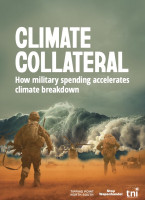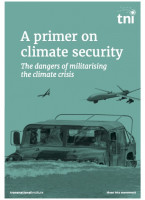Climate Collateral
Topics
War has always devoured life. It turns humans into those worthy of life and those who can be killed without thought. It flattens thousands of complex human beings into a faceless enemy. It snarls out slogans of ‘country’ and ‘land’ that are heralded as more important than human life. It buries the brutality of broken bodies behind the jargon of ‘collateral.’ Sadly, this is nothing new and we have seen it all unfold again in the horrors of the Ukraine war. But today, there is another sense in which war is devouring life since it is destroying the life of our planet’s biosphere and the lives of future generations.

Staff Sgt. James A. Richardson Jr./Air Force (public domain)
The war on Ukraine couldn’t have come at a worse time in our broader ecological crisis. Public awareness of the climate crisis may be at unprecedented levels, but political actions have failed to match the scale of the challenge. Meanwhile, time is running out as actions have to be taken this decade to have a chance of preventing run-away climate change. The Intergovernmental Panel on Climate Change warns that the world must reduce greenhouse gas emissions by 45% by 2030 to keep temperature rises below 1.5 degrees Celsius. As emissions are still rising globally, this requires a complete step-change in policy, which will only happen if climate action becomes the number one priority of the most powerful governments. Climate change has to be treated like it is a political emergency that is above all other domestic and foreign policy priorities or goals.
But in the fog of war and militarism, climate action is lucky to be considered at all let alone prioritized. In fact, militarism is deepening the climate crisis. By itself, the war in Ukraine led to 33 million tonnes of additional greenhouse gas emissions in the first six months, as a result of the missiles, fires, and fuel use – the equivalent of putting 14 million additional cars on the road. The war has also had devastating ecological impacts including extensive fires, increased industrial toxic spills, pollution of waterways and damage to important conservation areas. It is unlikely that the military generals responsible for this gave any more consideration to these impacts than they did to the human lives torn apart by the war. Beyond Ukraine, the war has led to a surge in rearmament everywhere, as Western politicians warn darkly of a new time of threats from the likes of Russia and China. The far more pressing threat of climate change has been pushed to the back burner.
Militarism has a direct impact on the climate crisis, because military equipment is heavily fossil-fuel dependent. Tanks, missiles and jets use extraordinary amounts of oil. The new F-35A fighter jet uses about 5,600 litres of oil per hour compared to 3,500 for the F-16 fighters that they are replacing. Not surprisingly, one calculation puts military emissions as making up at least 5.5% of total global emissions, which puts military and armed forces as one of the top sectors responsible for climate change. With the war justifying a surge in military spending everywhere, military emissions are sure to rise even further with long-term consequences. This is because much of the new equipment (such as the F-35A jets) has lifespans of around 30 to 40 years, so any purchases lock in carbon emissions well into the middle of this century. Yet there is currently no requirement for countries to report on their military-related emissions in their annual reports to the UN Framework Convention on Climate Change (UNFCCC), let alone commit to reductions.
Militarism also diverts critical financial resources from climate action. Even before the war, the balance between spending on the military and climate was completely skewed. The richest countries dedicate at least 30 times as much on military spending as they do on climate finance to the poorest countries. For more than a decade, the richest countries have promised and failed to provide $100 billion a year to the poorest countries to mitigate and adapt to climate change. The money was always ‘regretfully’ not there. Yet, there has been no similar problem in finding resources for military spending, which has consistently risen, even during the global economic crisis of 2008-2010.
The Russian invasion of Ukraine has only made this trend worse. In 2022, countless countries – especially in Europe – have announced increases in military spending with little public resistance. Germany approved a one-off increase of €100 billion, a dramatic 50% increase in funding. Some of this money is coming directly from climate budgets. The UK has shifted underspending from its climate finance budget to partially finance a £1 billion military support package for Ukraine. The Dutch government made cuts from its own climate funds – not including climate finance – to pay for new increases in military spending. Biden’s administration also approved its largest military budget ever of $854 billion in 2023, even while it was scaling back its initial ambitions to address climate change through its Inflation Reduction Act.
A good proportion of this funding is spent on equipment, so arms companies have been over the moon. Sales and profits have surged as nations have shipped old weapons to Ukraine and restocked. The US Senate is even considering plans that would allow arms manufacturers no-bid contracts on a rolling multi-year basis. Perhaps even more valuable than arms sales is the legitimacy that has been given to the arms industry, with its murky reputation due to a long history of corruption and support for authoritarian regimes. Guillaume Muesser of the French Aerospace Industries Association celebrated the war as “a game changer. It shows that war is still on the agenda, on our doorsteps, and that the defence industry is very useful.” There is already evidence that the arms industry is using this moment to try to roll back controls on exports, including to countries mired in conflict and bearing the brunt of the climate crisis.
The rise in militarism locks in an infrastructure of hard security that is fueled by the money and influence of arms companies, and predicated on ever more military spending. It will exacerbate a politics and language of ‘fear’ and ‘threat’ and make military solutions seem like the only option on the table. We can already see the ways this rhetoric and policy is dangerously ratcheting up between NATO countries and China.
The military infrastructure is similarly being readied to deal with climate change. Since the early 2000s, the richest countries’ military and national security agencies have been developing strategies to deal with climate change. Rather than address the causes of the climate crisis, they have focused on managing the consequences. Their strategies warn darkly of failed states, mass migration, and civil conflict, and propose increased military spending to respond. The 2022 US Army Climate Strategy, for example, predicts that “climate hazards will result in less economic and social stability, fewer goods to meet basic needs, and a less secure world.” Their primary answer to this is not scaling back military emissions, addressing the injustice at the heart of the climate crisis, or investing in peace, but ensuring that “the Army must remain ahead of adversaries seeking strategic positional advantages in a climate-altered world.”
This is not a surprise. As the famous adage goes, “if all you have is a hammer, everything looks like a nail.” It is the job of the US Army to consider long-term threats and to fight them. However, it is the job of society to decide what to invest in at a time of climate instability. Prioritizing investments in militarized security will mean that we are prioritizing resources for dealing with the consequences of climate injustice rather than its systemic causes. It means that the victims of climate change, such as displaced peoples and refugees, are all too easily turned into threats, leading to the militarized borders we already witness worldwide. It also means that climate crisis will worsen, as politicians avoid the systemic actions that are needed – a planned rapid shift from a fossil-fuel to renewable-based economy, a just transition for workers, and reparations for those most impacted by climate change. We may still be far away from these real climate solutions, but avoiding them will only deepen the crisis. In the end, there is no wall high enough or tank sophisticated enough to fend off climate instability and its human consequences.
For too long, climate activists have avoided talking about militarization. It has been seen as a distraction from focusing on the main enemy: the Big Oil firms. The military has even been seen as an ally in some quarters of the environmental movement, as it is an institution that has embraced climate science and not indulged in the climate denialism of the far right. However, allying with the military is a dangerous and ultimately self-defeating path for climate activists to take.
Militarism is deeply entwined in an unjust global economy that has created the climate crisis. The military has thrived because of Big Oil. Its operations are dependent on fossil fuels, it is deployed primarily to protect and guard oil infrastructure, and its ‘climate’ mandate today is to manage rather than resolve climate instability. This is a path towards ever more conflict, and a self-fulfilling cycle of ever more militarism to deal with the crises militarism creates. It is time to get off the treadmill and demilitarize if we want a just response to the climate crisis. The only climate safe and just future is one built on peace.
Related
Climate Collateral How military spending accelerates climate breakdown
- Climate Security
- Climate Crisis
- Mark Akkerman
- Deborah Burton
- Nick Buxton
- Ho-Chih Lin
- Muhammed Al-Kashef
- Wendela de Vries

Tags
Credits
Authors
Published at
Article: Newsletter banner
Do you want to stay informed?
Sign up for the newsletter to receive monthly updates on TNI’s research, events, and publications.
Newsletter Subscribe to our newsletter
More like this
-
Climate Collateral How military spending accelerates climate breakdown
- Climate Security
- Climate Crisis
Report byPublication date:- Mark Akkerman
- Deborah Burton
- Nick Buxton
- Ho-Chih Lin
- Muhammed Al-Kashef
- Wendela de Vries

-
Primer on climate security The dangers of militarising the climate crisis
- Climate Security
- Climate Crisis
Primer byPublication date:Nick Buxton
-
Global Climate Wall How the world’s wealthiest nations prioritise borders over climate action
- Border Wars
- Climate Crisis
- Climate Security
Report byPublication date:- Todd Miller
- Nick Buxton
- Mark Akkerman

